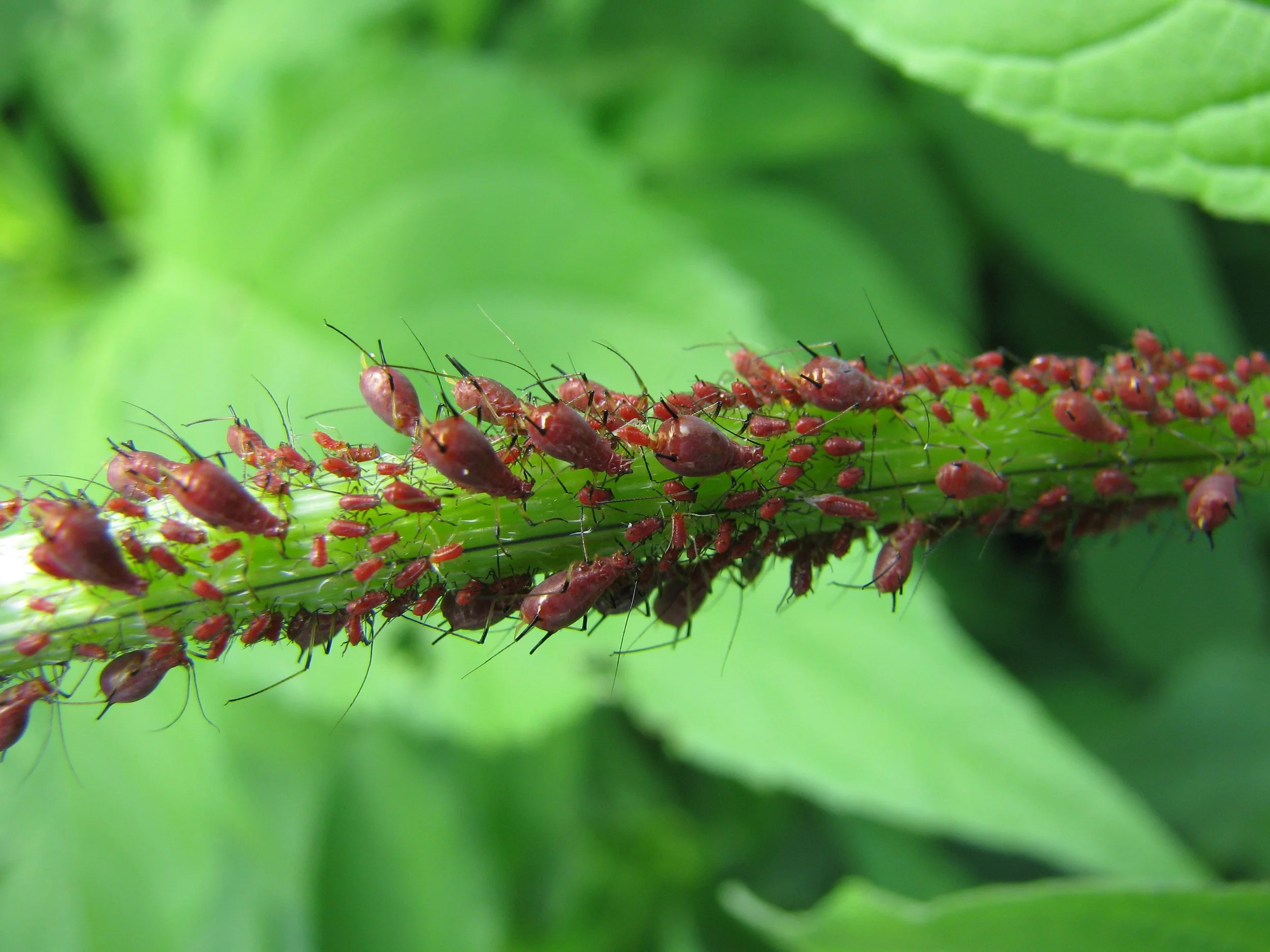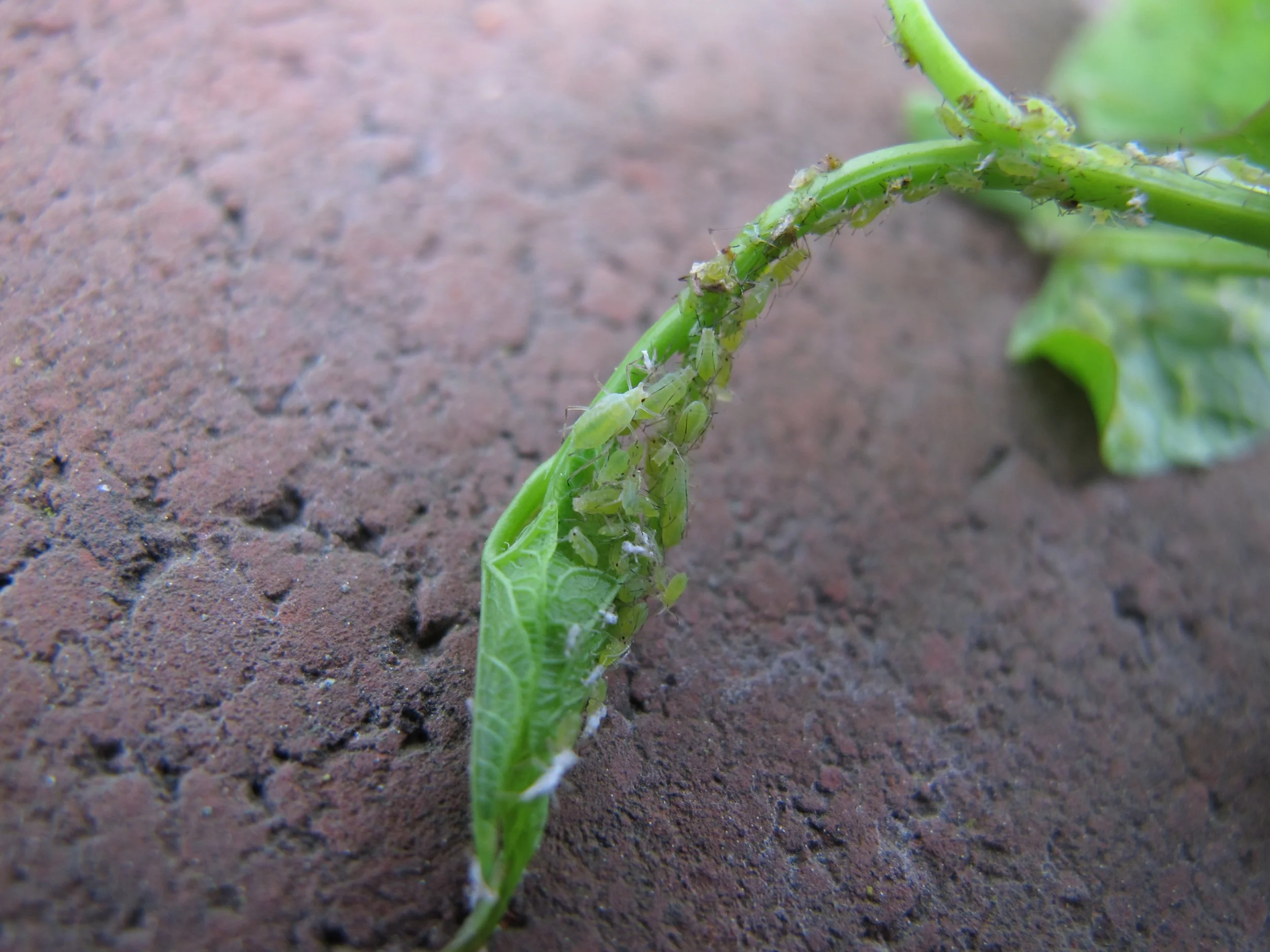Aphids are small, soft-bodied insects that feed on plant sap. Aphids are frequently found on tips of shoots and new growth.
For region-specific information, please contact your local Giving Grove partner. If you would like to see information like this in your inbox, consider subscribing to The Serving, The Giving Grove’s quarterly newsletter.
What are Aphids?
Aphids are small, soft bodied insects that feed on plant sap. They may be green, black, red, yellow, brown, or gray.
Aphids are frequently found on tips of shoots and new growth.
Aphids are hard to see; they can be green or other colors. The insects have piercing-sucking mouthparts. They multiply very quickly and can pass along many diseases.
Wooly Apple Aphids:
Woolly apple aphids infest roots, trunks, limbs, shoots, and occasionally the fruit of apple trees. The bodies of these bark-feeding aphids are completely covered by masses of white, wool-like, waxy materials, hence its name.
The adult is reddish-brown to purple. The actual color, however, is usually concealed beneath a white, cotton-like substance secreted from the aphid’s abdomen. This characteristic makes this aphid species easy to distinguish from other aphid species occurring on apple.
Rosy Apple Aphids:
The rosy apple aphid feeds on apple leaves and fruit in the summer.
Rosy apple aphid will attack all apple varieties, but Golden Delicious and Rome Beauty are among the more susceptible to fruit deformation. Although it prefers apple, it also feeds on pear.
Damage:
In many cases, the presence of aphids causes little or no damage to plants. Aphids attack many types of orchard plants, especially during the beginning and end of the growing season.
They favor the new succulent growth at the tips of the branches. Watch for curled or sticky leaves as a sign of Aphid damage. You may also see a sooty black layer on the leaves.
Signs of severe aphid feeding are twisted and curled leaves, yellowed leaves, stunted or dead shoots and poor plant growth.
Severe infestations of aphids can also lead to sooty mold buildup on foliage and fruit
Aphid feeding may also spread diseases
Wooly Apple Aphids:
The main injury to young and mature trees is stunting due to the formation of root galls. The galls are hard to see; watch for yellowing foliage. Roots of infested trees have large, abnormal swellings. Continued feeding can kill roots and cause reduced growth or even death of young trees.
Colonies may be found feeding below the ground tree roots of susceptible rootstocks, or above ground on previously wounded sites or at the base of new foliage.
If populations are high, honeydew and sooty mold will also be problems, and aphids may enter the calyx end of fruit.
Rosy Apple Aphid:
Feedings by rosy apple aphid causes leaves to curl and deforms shoots.
Toxic saliva injected into the tree as the aphid feeds on the leaves of fruit clusters stunts and distorts fruit growth resulting in small, misshapen apples.
Root growth and photosynthesis are also reduced.
Damage can be most severe on young trees where shoots can be distorted so badly that tree shape is permanently altered. Feeding aphids produce honeydew which drips onto the foliage or fruit. A sooty mold, Fumago vagaus Fries, can grow on the honeydew.
Timing:
Aphids can occur at any time that environmental conditions are favorable
Aphids attack many types of orchard plants, especially during the beginning and end of the growing season.
Treatment:
Minor infestations can easily be managed by hand rubbing, or with the water spray of a garden hose.
Beneficial insects (e.g., lady beetles & lacewings) help suppress populations, and can be promoted with the installation of an insectary garden. A ladybug can eat up to 50 aphids a day, and 5,000 aphids over its life.
When minor infestations begin to multiply – use a homemade or commercial insecticidal soap.
Neem sprays are also effective for persistent infestations.
Wooly Apple Aphids:
Aphelinus mali is a parasite that can completely control aerial colonies. Other biological controls include lady beetles, lacewing and hover fly. Outbreaks of woolly apple aphid are most common following the use of pyrethroid insecticides, which destroy natural enemies.
Begin by using resistant fruit varieties and rootstocks (see the Giving Grove recommended varieties) .
Pinch aphid infestations off terminal shoots on young trees if necessary.
If a severe problem persists, utilize a neem oil application (.5% concentration every four to seven days)
Rosy Apple Aphids:
There are many natural enemies that feed on rosy apple aphids; however, fruit size may be reduced before natural enemies bring the aphids under control.
Among the important predators are lady beetles, green lacewings, brown lacewings, syrphid fly larvae, and solider beetles.
Inseason sprays (even soap sprays) applied to control rosy apple aphid can kill natural enemies, allowing rosy apple aphid populations to increase.
Biological control, approved narrow range oil sprays, and the use of Neem and insecticidal soaps are organically acceptable.
Sources: Patrick L. Byers, Horticulture Specialist and Michael Phillips, “The Holistic Orchard”, Washington State University Extension, and UC-IPM. Additional photo sources: E. Beers.







